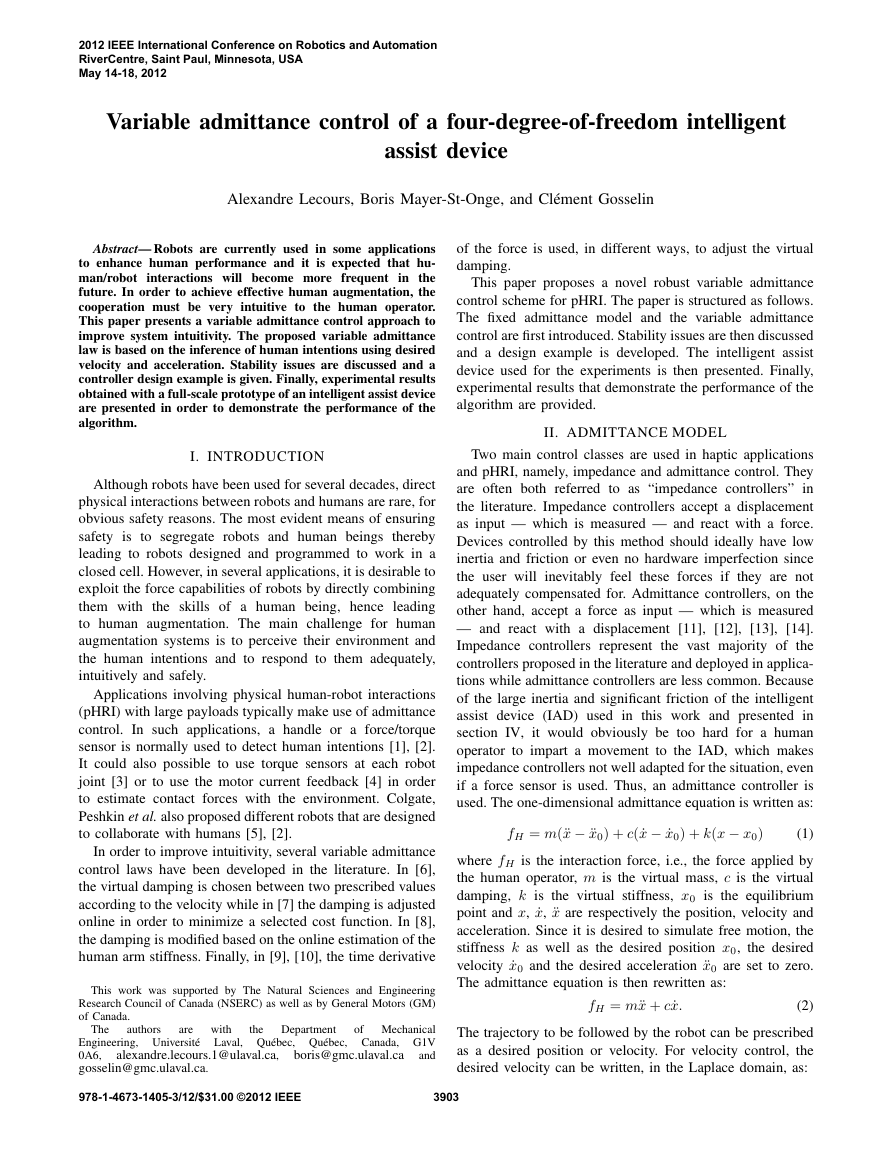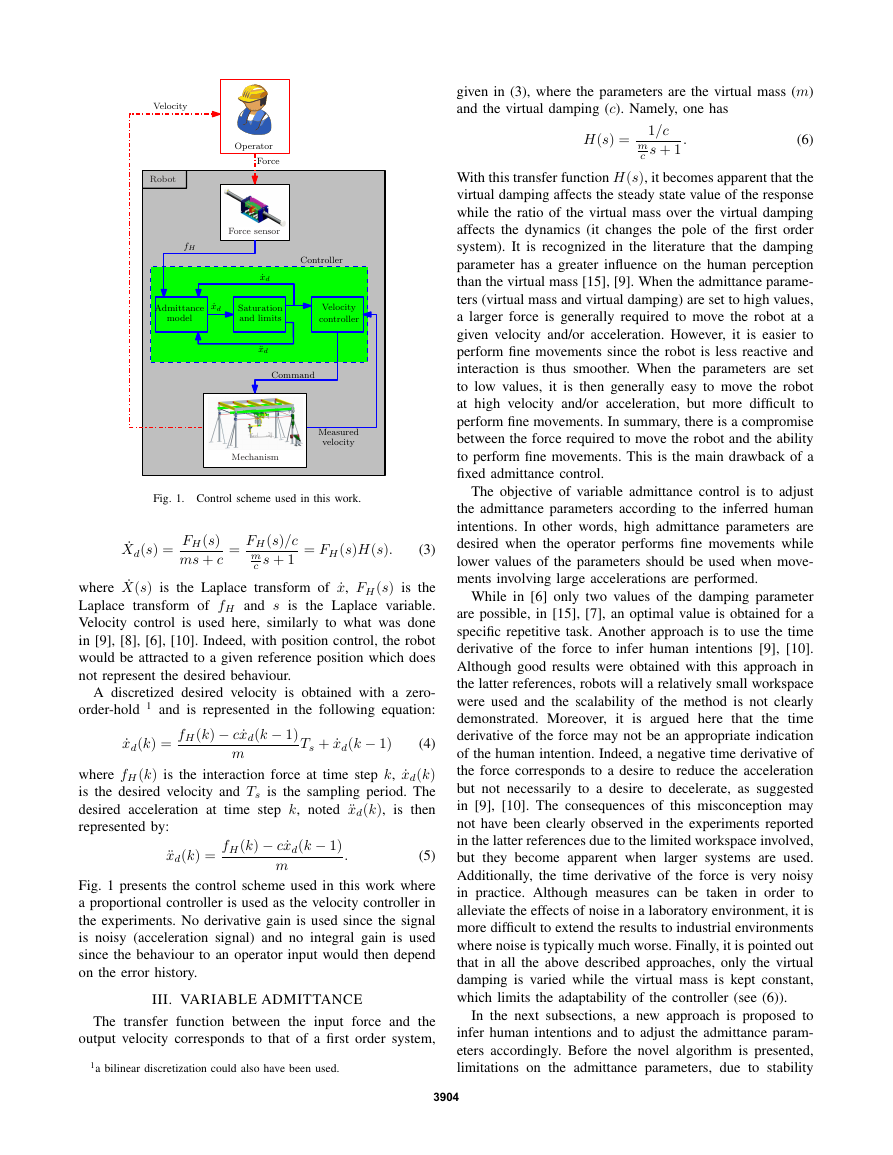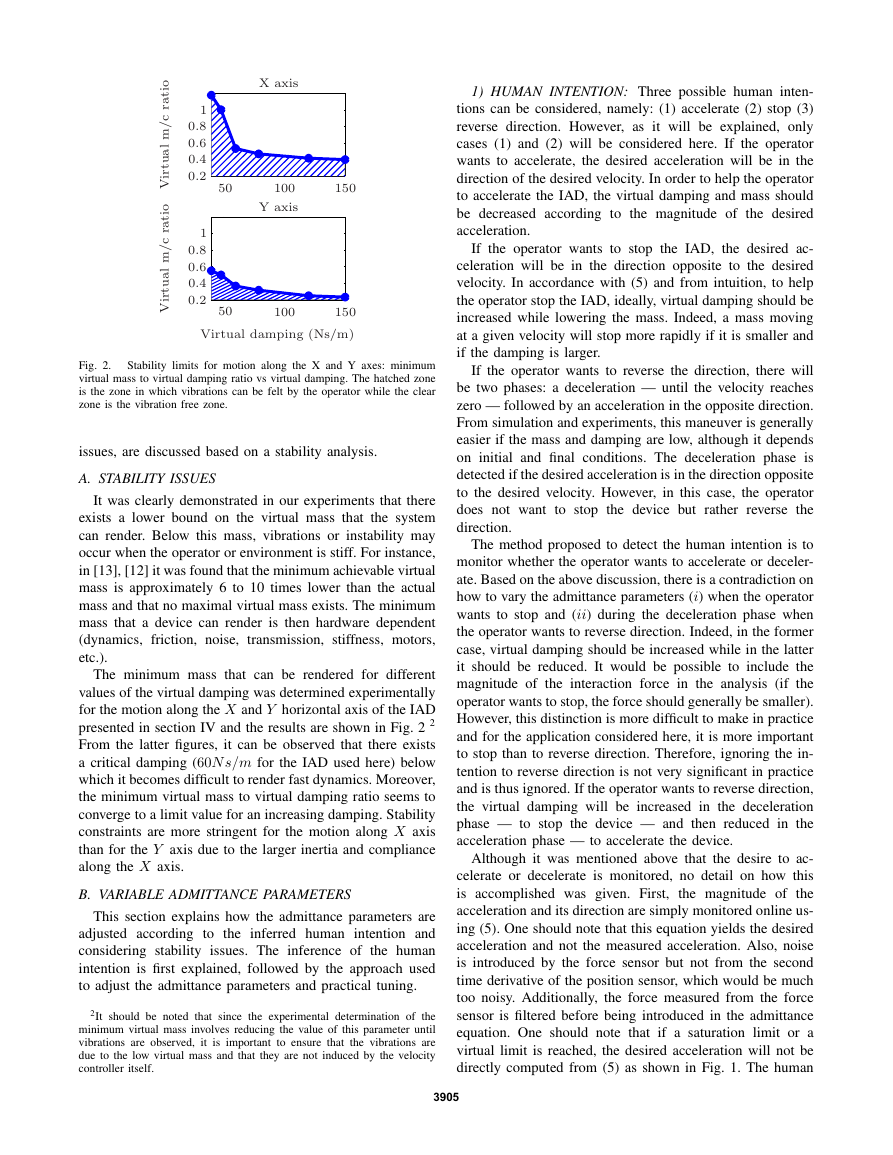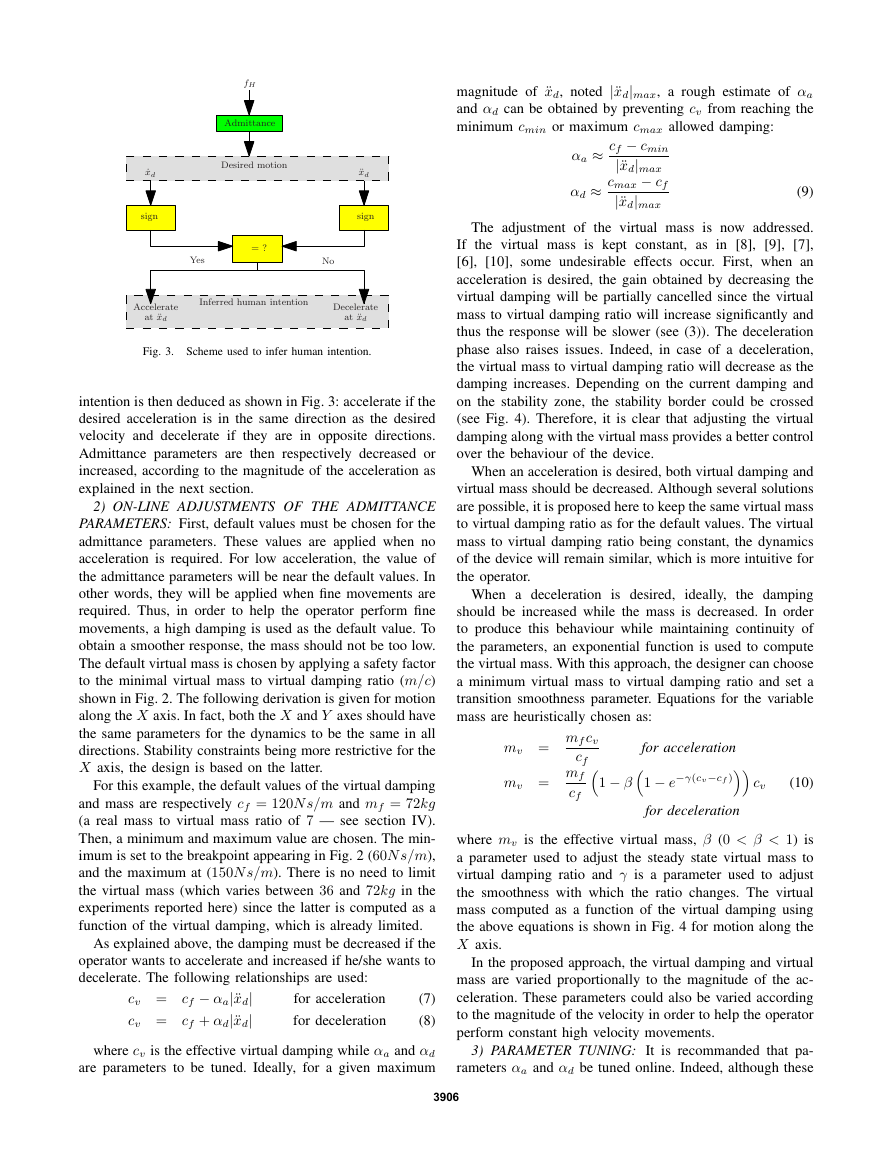2012 IEEE International Conference on Robotics and Automation
RiverCentre, Saint Paul, Minnesota, USA
May 14-18, 2012
978-1-4673-1405-3/12/$31.00 ©2012 IEEE
3903
Variableadmittancecontrolofafour-degree-of-freedomintelligentassistdeviceAlexandreLecours,BorisMayer-St-Onge,andCl´ementGosselinAbstract—Robotsarecurrentlyusedinsomeapplicationstoenhancehumanperformanceanditisexpectedthathu-man/robotinteractionswillbecomemorefrequentinthefuture.Inordertoachieveeffectivehumanaugmentation,thecooperationmustbeveryintuitivetothehumanoperator.Thispaperpresentsavariableadmittancecontrolapproachtoimprovesystemintuitivity.Theproposedvariableadmittancelawisbasedontheinferenceofhumanintentionsusingdesiredvelocityandacceleration.Stabilityissuesarediscussedandacontrollerdesignexampleisgiven.Finally,experimentalresultsobtainedwithafull-scaleprototypeofanintelligentassistdevicearepresentedinordertodemonstratetheperformanceofthealgorithm.I.INTRODUCTIONAlthoughrobotshavebeenusedforseveraldecades,directphysicalinteractionsbetweenrobotsandhumansarerare,forobvioussafetyreasons.Themostevidentmeansofensuringsafetyistosegregaterobotsandhumanbeingstherebyleadingtorobotsdesignedandprogrammedtoworkinaclosedcell.However,inseveralapplications,itisdesirabletoexploittheforcecapabilitiesofrobotsbydirectlycombiningthemwiththeskillsofahumanbeing,henceleadingtohumanaugmentation.Themainchallengeforhumanaugmentationsystemsistoperceivetheirenvironmentandthehumanintentionsandtorespondtothemadequately,intuitivelyandsafely.Applicationsinvolvingphysicalhuman-robotinteractions(pHRI)withlargepayloadstypicallymakeuseofadmittancecontrol.Insuchapplications,ahandleoraforce/torquesensorisnormallyusedtodetecthumanintentions[1],[2].Itcouldalsopossibletousetorquesensorsateachrobotjoint[3]ortousethemotorcurrentfeedback[4]inordertoestimatecontactforceswiththeenvironment.Colgate,Peshkinetal.alsoproposeddifferentrobotsthataredesignedtocollaboratewithhumans[5],[2].Inordertoimproveintuitivity,severalvariableadmittancecontrollawshavebeendevelopedintheliterature.In[6],thevirtualdampingischosenbetweentwoprescribedvaluesaccordingtothevelocitywhilein[7]thedampingisadjustedonlineinordertominimizeaselectedcostfunction.In[8],thedampingismodifiedbasedontheonlineestimationofthehumanarmstiffness.Finally,in[9],[10],thetimederivativeThisworkwassupportedbyTheNaturalSciencesandEngineeringResearchCouncilofCanada(NSERC)aswellasbyGeneralMotors(GM)ofCanada.TheauthorsarewiththeDepartmentofMechanicalEngineering,Universit´eLaval,Qu´ebec,Qu´ebec,Canada,G1V0A6,alexandre.lecours.1@ulaval.ca,boris@gmc.ulaval.caandgosselin@gmc.ulaval.ca.oftheforceisused,indifferentways,toadjustthevirtualdamping.ThispaperproposesanovelrobustvariableadmittancecontrolschemeforpHRI.Thepaperisstructuredasfollows.Thefixedadmittancemodelandthevariableadmittancecontrolarefirstintroduced.Stabilityissuesarethendiscussedandadesignexampleisdeveloped.Theintelligentassistdeviceusedfortheexperimentsisthenpresented.Finally,experimentalresultsthatdemonstratetheperformanceofthealgorithmareprovided.II.ADMITTANCEMODELTwomaincontrolclassesareusedinhapticapplicationsandpHRI,namely,impedanceandadmittancecontrol.Theyareoftenbothreferredtoas“impedancecontrollers”intheliterature.Impedancecontrollersacceptadisplacementasinput—whichismeasured—andreactwithaforce.Devicescontrolledbythismethodshouldideallyhavelowinertiaandfrictionorevennohardwareimperfectionsincetheuserwillinevitablyfeeltheseforcesiftheyarenotadequatelycompensatedfor.Admittancecontrollers,ontheotherhand,acceptaforceasinput—whichismeasured—andreactwithadisplacement[11],[12],[13],[14].Impedancecontrollersrepresentthevastmajorityofthecontrollersproposedintheliteratureanddeployedinapplica-tionswhileadmittancecontrollersarelesscommon.Becauseofthelargeinertiaandsignificantfrictionoftheintelligentassistdevice(IAD)usedinthisworkandpresentedinsectionIV,itwouldobviouslybetoohardforahumanoperatortoimpartamovementtotheIAD,whichmakesimpedancecontrollersnotwelladaptedforthesituation,evenifaforcesensorisused.Thus,anadmittancecontrollerisused.Theone-dimensionaladmittanceequationiswrittenas:fH=m(¨x−¨x0)+c(˙x−˙x0)+k(x−x0)(1)wherefHistheinteractionforce,i.e.,theforceappliedbythehumanoperator,misthevirtualmass,cisthevirtualdamping,kisthevirtualstiffness,x0istheequilibriumpointandx,˙x,¨xarerespectivelytheposition,velocityandacceleration.Sinceitisdesiredtosimulatefreemotion,thestiffnesskaswellasthedesiredpositionx0,thedesiredvelocity˙x0andthedesiredacceleration¨x0aresettozero.Theadmittanceequationisthenrewrittenas:fH=m¨x+c˙x.(2)Thetrajectorytobefollowedbytherobotcanbeprescribedasadesiredpositionorvelocity.Forvelocitycontrol,thedesiredvelocitycanbewritten,intheLaplacedomain,as:�
3904
AdmittancemodelSaturationandlimitsVelocitycontroller˙xd¨xd˙xdfHMeasuredvelocityVelocityOperatorForceRobotForcesensorMechanismControllerCommandFig.1.Controlschemeusedinthiswork.˙Xd(s)=FH(s)ms+c=FH(s)/cmcs+1=FH(s)H(s).(3)where˙X(s)istheLaplacetransformof˙x,FH(s)istheLaplacetransformoffHandsistheLaplacevariable.Velocitycontrolisusedhere,similarlytowhatwasdonein[9],[8],[6],[10].Indeed,withpositioncontrol,therobotwouldbeattractedtoagivenreferencepositionwhichdoesnotrepresentthedesiredbehaviour.Adiscretizeddesiredvelocityisobtainedwithazero-order-hold1andisrepresentedinthefollowingequation:˙xd(k)=fH(k)−c˙xd(k−1)mTs+˙xd(k−1)(4)wherefH(k)istheinteractionforceattimestepk,˙xd(k)isthedesiredvelocityandTsisthesamplingperiod.Thedesiredaccelerationattimestepk,noted¨xd(k),isthenrepresentedby:¨xd(k)=fH(k)−c˙xd(k−1)m.(5)Fig.1presentsthecontrolschemeusedinthisworkwhereaproportionalcontrollerisusedasthevelocitycontrollerintheexperiments.Noderivativegainisusedsincethesignalisnoisy(accelerationsignal)andnointegralgainisusedsincethebehaviourtoanoperatorinputwouldthendependontheerrorhistory.III.VARIABLEADMITTANCEThetransferfunctionbetweentheinputforceandtheoutputvelocitycorrespondstothatofafirstordersystem,1abilineardiscretizationcouldalsohavebeenused.givenin(3),wheretheparametersarethevirtualmass(m)andthevirtualdamping(c).Namely,onehasH(s)=1/cmcs+1.(6)WiththistransferfunctionH(s),itbecomesapparentthatthevirtualdampingaffectsthesteadystatevalueoftheresponsewhiletheratioofthevirtualmassoverthevirtualdampingaffectsthedynamics(itchangesthepoleofthefirstordersystem).Itisrecognizedintheliteraturethatthedampingparameterhasagreaterinfluenceonthehumanperceptionthanthevirtualmass[15],[9].Whentheadmittanceparame-ters(virtualmassandvirtualdamping)aresettohighvalues,alargerforceisgenerallyrequiredtomovetherobotatagivenvelocityand/oracceleration.However,itiseasiertoperformfinemovementssincetherobotislessreactiveandinteractionisthussmoother.Whentheparametersaresettolowvalues,itisthengenerallyeasytomovetherobotathighvelocityand/oracceleration,butmoredifficulttoperformfinemovements.Insummary,thereisacompromisebetweentheforcerequiredtomovetherobotandtheabilitytoperformfinemovements.Thisisthemaindrawbackofafixedadmittancecontrol.Theobjectiveofvariableadmittancecontrolistoadjusttheadmittanceparametersaccordingtotheinferredhumanintentions.Inotherwords,highadmittanceparametersaredesiredwhentheoperatorperformsfinemovementswhilelowervaluesoftheparametersshouldbeusedwhenmove-mentsinvolvinglargeaccelerationsareperformed.Whilein[6]onlytwovaluesofthedampingparameterarepossible,in[15],[7],anoptimalvalueisobtainedforaspecificrepetitivetask.Anotherapproachistousethetimederivativeoftheforcetoinferhumanintentions[9],[10].Althoughgoodresultswereobtainedwiththisapproachinthelatterreferences,robotswillarelativelysmallworkspacewereusedandthescalabilityofthemethodisnotclearlydemonstrated.Moreover,itisarguedherethatthetimederivativeoftheforcemaynotbeanappropriateindicationofthehumanintention.Indeed,anegativetimederivativeoftheforcecorrespondstoadesiretoreducetheaccelerationbutnotnecessarilytoadesiretodecelerate,assuggestedin[9],[10].Theconsequencesofthismisconceptionmaynothavebeenclearlyobservedintheexperimentsreportedinthelatterreferencesduetothelimitedworkspaceinvolved,buttheybecomeapparentwhenlargersystemsareused.Additionally,thetimederivativeoftheforceisverynoisyinpractice.Althoughmeasurescanbetakeninordertoalleviatetheeffectsofnoiseinalaboratoryenvironment,itismoredifficulttoextendtheresultstoindustrialenvironmentswherenoiseistypicallymuchworse.Finally,itispointedoutthatinalltheabovedescribedapproaches,onlythevirtualdampingisvariedwhilethevirtualmassiskeptconstant,whichlimitstheadaptabilityofthecontroller(see(6)).Inthenextsubsections,anewapproachisproposedtoinferhumanintentionsandtoadjusttheadmittanceparam-etersaccordingly.Beforethenovelalgorithmispresented,limitationsontheadmittanceparameters,duetostability�
3905
Virtualm/cratioVirtualm/cratioVirtualdamping(Ns/m)XaxisYaxis0.20.20.40.40.60.60.80.8115050100100150150Fig.2.StabilitylimitsformotionalongtheXandYaxes:minimumvirtualmasstovirtualdampingratiovsvirtualdamping.Thehatchedzoneisthezoneinwhichvibrationscanbefeltbytheoperatorwhiletheclearzoneisthevibrationfreezone.issues,arediscussedbasedonastabilityanalysis.A.STABILITYISSUESItwasclearlydemonstratedinourexperimentsthatthereexistsalowerboundonthevirtualmassthatthesystemcanrender.Belowthismass,vibrationsorinstabilitymayoccurwhentheoperatororenvironmentisstiff.Forinstance,in[13],[12]itwasfoundthattheminimumachievablevirtualmassisapproximately6to10timeslowerthantheactualmassandthatnomaximalvirtualmassexists.Theminimummassthatadevicecanrenderisthenhardwaredependent(dynamics,friction,noise,transmission,stiffness,motors,etc.).TheminimummassthatcanberenderedfordifferentvaluesofthevirtualdampingwasdeterminedexperimentallyforthemotionalongtheXandYhorizontalaxisoftheIADpresentedinsectionIVandtheresultsareshowninFig.22Fromthelatterfigures,itcanbeobservedthatthereexistsacriticaldamping(60Ns/mfortheIADusedhere)belowwhichitbecomesdifficulttorenderfastdynamics.Moreover,theminimumvirtualmasstovirtualdampingratioseemstoconvergetoalimitvalueforanincreasingdamping.StabilityconstraintsaremorestringentforthemotionalongXaxisthanfortheYaxisduetothelargerinertiaandcompliancealongtheXaxis.B.VARIABLEADMITTANCEPARAMETERSThissectionexplainshowtheadmittanceparametersareadjustedaccordingtotheinferredhumanintentionandconsideringstabilityissues.Theinferenceofthehumanintentionisfirstexplained,followedbytheapproachusedtoadjusttheadmittanceparametersandpracticaltuning.2Itshouldbenotedthatsincetheexperimentaldeterminationoftheminimumvirtualmassinvolvesreducingthevalueofthisparameteruntilvibrationsareobserved,itisimportanttoensurethatthevibrationsareduetothelowvirtualmassandthattheyarenotinducedbythevelocitycontrolleritself.1)HUMANINTENTION:Threepossiblehumaninten-tionscanbeconsidered,namely:(1)accelerate(2)stop(3)reversedirection.However,asitwillbeexplained,onlycases(1)and(2)willbeconsideredhere.Iftheoperatorwantstoaccelerate,thedesiredaccelerationwillbeinthedirectionofthedesiredvelocity.InordertohelptheoperatortoacceleratetheIAD,thevirtualdampingandmassshouldbedecreasedaccordingtothemagnitudeofthedesiredacceleration.IftheoperatorwantstostoptheIAD,thedesiredac-celerationwillbeinthedirectionoppositetothedesiredvelocity.Inaccordancewith(5)andfromintuition,tohelptheoperatorstoptheIAD,ideally,virtualdampingshouldbeincreasedwhileloweringthemass.Indeed,amassmovingatagivenvelocitywillstopmorerapidlyifitissmallerandifthedampingislarger.Iftheoperatorwantstoreversethedirection,therewillbetwophases:adeceleration—untilthevelocityreacheszero—followedbyanaccelerationintheoppositedirection.Fromsimulationandexperiments,thismaneuverisgenerallyeasierifthemassanddampingarelow,althoughitdependsoninitialandfinalconditions.Thedecelerationphaseisdetectedifthedesiredaccelerationisinthedirectionoppositetothedesiredvelocity.However,inthiscase,theoperatordoesnotwanttostopthedevicebutratherreversethedirection.Themethodproposedtodetectthehumanintentionistomonitorwhethertheoperatorwantstoaccelerateordeceler-ate.Basedontheabovediscussion,thereisacontradictiononhowtovarytheadmittanceparameters(i)whentheoperatorwantstostopand(ii)duringthedecelerationphasewhentheoperatorwantstoreversedirection.Indeed,intheformercase,virtualdampingshouldbeincreasedwhileinthelatteritshouldbereduced.Itwouldbepossibletoincludethemagnitudeoftheinteractionforceintheanalysis(iftheoperatorwantstostop,theforceshouldgenerallybesmaller).However,thisdistinctionismoredifficulttomakeinpracticeandfortheapplicationconsideredhere,itismoreimportanttostopthantoreversedirection.Therefore,ignoringthein-tentiontoreversedirectionisnotverysignificantinpracticeandisthusignored.Iftheoperatorwantstoreversedirection,thevirtualdampingwillbeincreasedinthedecelerationphase—tostopthedevice—andthenreducedintheaccelerationphase—toacceleratethedevice.Althoughitwasmentionedabovethatthedesiretoac-celerateordecelerateismonitored,nodetailonhowthisisaccomplishedwasgiven.First,themagnitudeoftheaccelerationanditsdirectionaresimplymonitoredonlineus-ing(5).Oneshouldnotethatthisequationyieldsthedesiredaccelerationandnotthemeasuredacceleration.Also,noiseisintroducedbytheforcesensorbutnotfromthesecondtimederivativeofthepositionsensor,whichwouldbemuchtoonoisy.Additionally,theforcemeasuredfromtheforcesensorisfilteredbeforebeingintroducedintheadmittanceequation.Oneshouldnotethatifasaturationlimitoravirtuallimitisreached,thedesiredaccelerationwillnotbedirectlycomputedfrom(5)asshowninFig.1.Thehuman�
3906
˙xd¨xdDesiredmotionsignsign=?YesNoAccelerateat¨xdDecelerateat¨xdInferredhumanintentionAdmittancefHFig.3.Schemeusedtoinferhumanintention.intentionisthendeducedasshowninFig.3:accelerateifthedesiredaccelerationisinthesamedirectionasthedesiredvelocityanddecelerateiftheyareinoppositedirections.Admittanceparametersarethenrespectivelydecreasedorincreased,accordingtothemagnitudeoftheaccelerationasexplainedinthenextsection.2)ON-LINEADJUSTMENTSOFTHEADMITTANCEPARAMETERS:First,defaultvaluesmustbechosenfortheadmittanceparameters.Thesevaluesareappliedwhennoaccelerationisrequired.Forlowacceleration,thevalueoftheadmittanceparameterswillbenearthedefaultvalues.Inotherwords,theywillbeappliedwhenfinemovementsarerequired.Thus,inordertohelptheoperatorperformfinemovements,ahighdampingisusedasthedefaultvalue.Toobtainasmootherresponse,themassshouldnotbetoolow.Thedefaultvirtualmassischosenbyapplyingasafetyfactortotheminimalvirtualmasstovirtualdampingratio(m/c)showninFig.2.ThefollowingderivationisgivenformotionalongtheXaxis.Infact,boththeXandYaxesshouldhavethesameparametersforthedynamicstobethesameinalldirections.StabilityconstraintsbeingmorerestrictivefortheXaxis,thedesignisbasedonthelatter.Forthisexample,thedefaultvaluesofthevirtualdampingandmassarerespectivelycf=120Ns/mandmf=72kg(arealmasstovirtualmassratioof7—seesectionIV).Then,aminimumandmaximumvaluearechosen.Themin-imumissettothebreakpointappearinginFig.2(60Ns/m),andthemaximumat(150Ns/m).Thereisnoneedtolimitthevirtualmass(whichvariesbetween36and72kgintheexperimentsreportedhere)sincethelatteriscomputedasafunctionofthevirtualdamping,whichisalreadylimited.Asexplainedabove,thedampingmustbedecreasediftheoperatorwantstoaccelerateandincreasedifhe/shewantstodecelerate.Thefollowingrelationshipsareused:cv=cf−αa|¨xd|foracceleration(7)cv=cf+αd|¨xd|fordeceleration(8)wherecvistheeffectivevirtualdampingwhileαaandαdareparameterstobetuned.Ideally,foragivenmaximummagnitudeof¨xd,noted|¨xd|max,aroughestimateofαaandαdcanbeobtainedbypreventingcvfromreachingtheminimumcminormaximumcmaxalloweddamping:αa≈cf−cmin|¨xd|maxαd≈cmax−cf|¨xd|max(9)Theadjustmentofthevirtualmassisnowaddressed.Ifthevirtualmassiskeptconstant,asin[8],[9],[7],[6],[10],someundesirableeffectsoccur.First,whenanaccelerationisdesired,thegainobtainedbydecreasingthevirtualdampingwillbepartiallycancelledsincethevirtualmasstovirtualdampingratiowillincreasesignificantlyandthustheresponsewillbeslower(see(3)).Thedecelerationphasealsoraisesissues.Indeed,incaseofadeceleration,thevirtualmasstovirtualdampingratiowilldecreaseasthedampingincreases.Dependingonthecurrentdampingandonthestabilityzone,thestabilitybordercouldbecrossed(seeFig.4).Therefore,itisclearthatadjustingthevirtualdampingalongwiththevirtualmassprovidesabettercontroloverthebehaviourofthedevice.Whenanaccelerationisdesired,bothvirtualdampingandvirtualmassshouldbedecreased.Althoughseveralsolutionsarepossible,itisproposedheretokeepthesamevirtualmasstovirtualdampingratioasforthedefaultvalues.Thevirtualmasstovirtualdampingratiobeingconstant,thedynamicsofthedevicewillremainsimilar,whichismoreintuitivefortheoperator.Whenadecelerationisdesired,ideally,thedampingshouldbeincreasedwhilethemassisdecreased.Inordertoproducethisbehaviourwhilemaintainingcontinuityoftheparameters,anexponentialfunctionisusedtocomputethevirtualmass.Withthisapproach,thedesignercanchooseaminimumvirtualmasstovirtualdampingratioandsetatransitionsmoothnessparameter.Equationsforthevariablemassareheuristicallychosenas:mv=mfcvcfforaccelerationmv=mfcf1−β1−e−γ(cv−cf)cv(10)fordecelerationwheremvistheeffectivevirtualmass,β(0<β<1)isaparameterusedtoadjustthesteadystatevirtualmasstovirtualdampingratioandγisaparameterusedtoadjustthesmoothnesswithwhichtheratiochanges.ThevirtualmasscomputedasafunctionofthevirtualdampingusingtheaboveequationsisshowninFig.4formotionalongtheXaxis.Intheproposedapproach,thevirtualdampingandvirtualmassarevariedproportionallytothemagnitudeoftheac-celeration.Theseparameterscouldalsobevariedaccordingtothemagnitudeofthevelocityinordertohelptheoperatorperformconstanthighvelocitymovements.3)PARAMETERTUNING:Itisrecommandedthatpa-rametersαaandαdbetunedonline.Indeed,althoughthese�
3907
Virtualm/cratioVirtualdamping(Ns/m)MinimummassSelectedmass(β=0.25andγ=0.15)Minimumandmaximumdamping0.20.30.40.50.60.70.80.91.11.21406080120140160100Fig.4.StabilitylimitsandcontrollerparameterdesignformotionalongtheXaxis:minimumvirtualmasstovirtualdampingratiovsvirtualdampingforXaxismotion.Thehatchedzoneisthezoneinwhichvibrationscanbefeltbytheoperatorwhiletheclearzoneisthevibrationfreezone.parameterscouldbetunedusingsimulationdataorwithrecordedforcedata(inputtingtheforcedatain(4)),humanperceptionisveryimportantandsubjectivewhichsuggeststhatanonlineprocedureshouldleadtobetterresults.Asmentionedabove,anestimationofαaandαdcanbeobtainedfromtheanticipatedmaximummagnitudeof¨xdusing(9).Finally,experimentscanbeconductedwiththerobotfortypicaltasksandhighaccelerations.Monitoringthevirtualdampingduringsuchexperimentsprovidesagoodindicationonhowtosettheαaandαdparameterssothatthevirtualdampingeffectivelyusestherangeofvariationavailablebetweentheminimumandmaximumvalues.IV.PROTOTYPEOFA4-DOFINTELLIGENTASSISTDEVICETherobotusedfortheexperimentsreportedinthispaperisaprototypeofa4-DOFintelligentassistdevice(IAD),showninFig.5,allowingtranslationsinalldirections(XYZ)andarotation(θ)abouttheverticalaxis.Inthisprototype,thetotalmovingmassisapproximately500kginthedirectionoftheXaxisand325kgalongtheYaxis.Additionally,thepayloadmayvarybetween0and113kg.Thehorizontalworkspaceis3.3m×2.15mwhiletheverticalrangeofmotionis0.52m.Therangeofrotationabouttheverticalaxisis120◦.Threedifferentcontrolmodesarepossible:autonomousmotion,unpoweredmanualmotionandinteractivemotion(cooperation).Inthispaper,onlythelatterisaddressed.Thecontrollerisimplementedonareal-timeQNXcomputerwithasamplingperiodof2ms.Thealgorithmsareprogrammedusingsimulink/RT-LABsoftware.V.EXPERIMENTATIONInordertodemonstratetheeffectivenessoftheproposedvariableadmittancemethod,twoexperimentationswereper-formed.ThefirstoneconsistsinadrawingtaskwhilethesecondexperimentconsistedingivinganimpulsetotheFig.5.Prototypeofa4-DOFintelligentassistdevice.Time(s)Overshoots(cm)LowadmittanceHighadmittanceVariableadmittance051015202530354045505560Fig.6.Totallengthofovershootsversusthetimeneededtocompletethedrawingtask(pathandmaze).Eachsubjectexecutedtwotrialsforeachsetofadmittanceparameters.Largermarksrepresenttheaverageofthecorrespondinggroupofresults.assistdevice.Avideoextensionofthispapershowsexcerptsoftheexperiments.A.DRAWINGTASKThedrawingtaskconsistedinstartingfromagivenpoint,advancefor1.5m,getaroundanobstaclebyturning90◦,advance1.25mandthenmovetothedrawingboardbyperforminga1mlateraldisplacement.Finally,theoperatorhadtofollowthemazewhiletracingthepathonapieceofpaperwithapenmountedontheIADat1.4metrefromtheoperator.Theinstructionsweretominimizethetotaltimewhileminimizingtheovershootsinthemaze.Experimentswereperformedfor3setsofparameters,namely:i)fixedlowadmittanceparameters(c=60Ns/mandm=36kg),ii)fixedhighadmittanceparameters(c=120Ns/mandm=72kg)andiii)variableadmittancewithdefaultvaluesofcf=120Ns/m,mf=72kgandαa=αd=10.Theexperimentwasperformedby6subjectsagedbetween24and38.Taskcompletiontime,mazeovershootsandsub-jectcommentswererecorded.Aftersomepracticeruns,eachsubjectperformedthetask3timesforeachsetofadmittanceparameters.Foreachsetofadmittanceparameters,all3testswereperformedoneaftertheother,withthefirsttestbeingonlyapracticetrial.Subjectswerenottoldwhichparameter�
3908
setwasusedandtheorderwasvariedbetweensubjects.Fig.6showsthetaskcompletiontimeandthetotallengthofovershoots(thetotallengthofthecurveoutsidethemaze)forallsubjectsandallparametersets.Inaccordancewiththisfigure,subjectscommentedthatforthelowadmittancecase,itwaseasytoacceleratebuthardertoperformfinemovements.Ontheotherhand,theyreporteditwaseasytoperformfinemovementsinthehighadmittancecase,whileahigherforcewasrequiredforaccelerationmovements.Finally,withvariableparameters,boththeaccelerationandfinemovementsphaseswereeasytoperform.Theaveragetimetocompletethetaskwithvariableparametersissimilartothatobtainedwiththelowadmittanceparametersand20%lowerthanthetimeneededwiththehighadmittanceparameters.Additionally,thedistanceofovershootobtainedwiththevariableparametersissimilartothatobtainedwithhighadmittanceparameterswhilebeingfivetimeslowerthantheovershootdistanceobtainedwiththelowadmittanceparameters.B.IMPULSEAverysimpletesttoassesstheeffectivenessoftheproposedapproachconsistsinaskinganoperatortoapplyanimpulsetotheIAD.Theimpulsetestwasperformedwithlowfixedadmittance,withahighfixedadmittance,aswellaswithavariableadmittance,similarlytothedrawingtask.Sinceitisnotpossibleforapersontorepeatedlyapplyidenticalimpulses,animpulsewasrecordedandthenusedastheforceinputinsteadoftheforcesensor.Fig.7presentstheimpulseforce,position,desiredvelocityandaccelerationandvirtualdampingandmass.Forsuchhighvaluesofdesiredaccelerations,thedesiredvelocityandaccelerationobtainedwiththevariableadmittanceschemearesimilartothoseobtainedwiththelowadmittancepa-rameters,whichhelpstheoperatortoaccelerate.However,theabilitytoperformfinemovementsremainssince,inthisphase,thevariableparameterswillbeneartheirdefaultvalues.Moreover,withthevariableadmittanceparameters,thevelocitydecaysmorerapidly,duetoahigheraccelerationcausedbythevariableadmittancecontrollaw.CONCLUSIONAvariableadmittancecontrolapproachbasedontheinfer-enceofhumanintentionsusingdesiredvelocityandacceler-ationwaspresented.Theobjectivesetforthfromtheoutset,i.e.,toeliminatethetradeoffsinherenttofixedadmittancecontrolwassuccessfullyachieved.Stabilityissuesalongwithacontrollerdesignexamplewerealsopresented.Finally,theeffectivenessoftheproposedapproachwasdemonstratedwithexperimentsperformedonafull-scaleprototypeofanintelligentassistdevice.REFERENCES[1]K.KosugeandN.Kazamura,“Controlofarobothandlinganobjectincooperationwithahuman,”in6thIEEEInternationalWorkshopRO-MANProceedings.,1997,pp.142–147.Force(N)Velocity(m/s)Position(m)Acceleration(m/s2)Damping(Ns/m)Mass(kg)Time(s)Time(s)00000000000.50.5112222222-24444442020-204040506080100150Fig.7.System’sresponsetoanimpulse.Exceptfortheforcesubplot,thesolidbluelinerepresentstheresultsobtainedwithafixedhighadmittance,thereddashedlinerepresentstheresultsobtainedwithafixedlowadmittanceandthegreendash-dotlinerepresentstheresultsobtainedwithavariableadmittance.[2]J.E.Colgate,M.Peshkin,andS.H.Klostermeyer,“Intelligentassistdevicesinindustrialapplications:areview,”inProceedingsoftheInternationalConferenceonIntelligentRobotsandSystems,2003,pp.2516–2521.[3]G.Grunwald,G.Schreiber,A.Albu-Schaffer,andG.Hirzinger,“Touch:Thedirecttypeofhumaninteractionwitharedundantservicerobot,”inProceedingsoftheIEEEInternationalWorkshoponRobotandHumanInteractiveCommunication,2001,pp.347–352.[4]S.Kobayashi,A.Muis,andK.Ohnishi,“Sensorlesscooperationbetweenhumanandmobilemanipulator,”inIEEEInternationalCon-ferenceonIndustrialTechnology,2005,pp.811–816.[5]M.Peshkin,J.Colgate,W.Wannasuphoprasit,C.Moore,R.Gillespie,andP.Akella,“Cobotarchitecture,”IEEETransactionsonRoboticsandAutomation,Vol.17,No.4,pp.377–390,2001.[6]R.IkeuraandH.Inooka,“Variableimpedancecontrolofarobotforcooperationwithahuman,”inProceedingsoftheIEEEInternationalConferenceonRoboticsandAutomation,Vol.3,1995,pp.3097–3102.[7]R.Ikeura,T.Moriguchi,andK.Mizutani,“Optimalvariableimpedancecontrolforarobotanditsapplicationtoliftinganobjectwithahuman,”inProceedingsoftheIEEEInternationalWorkshoponRobotandHumanInteractiveCommunication,2002,pp.500–505.[8]T.Tsumugiwa,R.Yokogawa,andK.Hara,“Variableimpedancecontrolbasedonestimationofhumanarmstiffnessforhuman-robotcooperativecalligraphictask,”inIEEEInternationalConferenceonRoboticsandAutomation,Vol.1,2002,pp.644–650.[9]V.DuchaineandC.M.Gosselin,“Generalmodelofhuman-robotcooperationusinganovelvelocitybasedvariableimpedancecontrol,”inProceedingsoftheWorldHaptics,mar.2007,pp.446–451.[10]T.Tsumugiwa,R.Yokogawa,andK.Hara,“Variableimpedancecon-trolwithregardtoworkingprocessforman-machinecooperation-worksystem,”inProceedingsoftheIEEE/RSJInternationalConferenceonIntelligentRobotsandSystems,Vol.3,2001,pp.1564–1569.[11]V.HaywardandK.Maclean,“Doityourselfhaptics:parti,”IEEERoboticsAutomationMagazine,Vol.14,No.4,pp.88–104,2007.[12]P.Lammertse,“Admittancecontrolandimpedancecontrol-adual,”www.haptist.com/resources/Lammertse2004admittanceimpedancecontroldual.pdf,2004,visited15march2011.[13]R.v.d.Linde,“Hapticmaster-agenericforcecontrolledrobotforhumaninteraction,”IndustrialRobot:AnInternationalJournal,Vol.30,pp.515–524,2003.[14]P.Lammertse,E.Frederiksen,andB.Ruiter,“Thehapticmaster,anewhigh-performancehapticinterface,”inProceedingsofEurohaptics2002,Edinburgh,UK,2002.[15]R.Ikeura,H.Monden,andH.Inooka,“Cooperativemotioncontrolofarobotandahuman,”inProceedingsofthe3rdIEEEInternationalWorkshoponRobotandHumanCommunication,1994,pp.112–117.�












 2023年江西萍乡中考道德与法治真题及答案.doc
2023年江西萍乡中考道德与法治真题及答案.doc 2012年重庆南川中考生物真题及答案.doc
2012年重庆南川中考生物真题及答案.doc 2013年江西师范大学地理学综合及文艺理论基础考研真题.doc
2013年江西师范大学地理学综合及文艺理论基础考研真题.doc 2020年四川甘孜小升初语文真题及答案I卷.doc
2020年四川甘孜小升初语文真题及答案I卷.doc 2020年注册岩土工程师专业基础考试真题及答案.doc
2020年注册岩土工程师专业基础考试真题及答案.doc 2023-2024学年福建省厦门市九年级上学期数学月考试题及答案.doc
2023-2024学年福建省厦门市九年级上学期数学月考试题及答案.doc 2021-2022学年辽宁省沈阳市大东区九年级上学期语文期末试题及答案.doc
2021-2022学年辽宁省沈阳市大东区九年级上学期语文期末试题及答案.doc 2022-2023学年北京东城区初三第一学期物理期末试卷及答案.doc
2022-2023学年北京东城区初三第一学期物理期末试卷及答案.doc 2018上半年江西教师资格初中地理学科知识与教学能力真题及答案.doc
2018上半年江西教师资格初中地理学科知识与教学能力真题及答案.doc 2012年河北国家公务员申论考试真题及答案-省级.doc
2012年河北国家公务员申论考试真题及答案-省级.doc 2020-2021学年江苏省扬州市江都区邵樊片九年级上学期数学第一次质量检测试题及答案.doc
2020-2021学年江苏省扬州市江都区邵樊片九年级上学期数学第一次质量检测试题及答案.doc 2022下半年黑龙江教师资格证中学综合素质真题及答案.doc
2022下半年黑龙江教师资格证中学综合素质真题及答案.doc